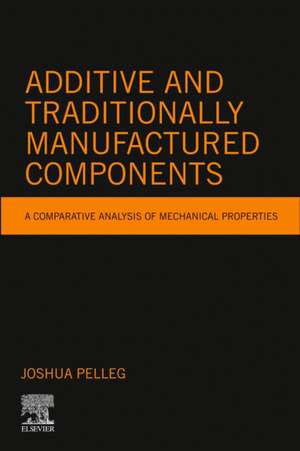Additive and Traditionally Manufactured Components: A Comparative Analysis of Mechanical Properties
Autor Joshua Pellegen Limba Engleză Paperback – 29 apr 2020
Testing of AM fabricated specimens, including tension, compression and hardness is included, along with a comparison of those results to specimens obtained by conventional fabrication methods. Topics covered include static deformation, time dependent deformation (creep), cyclic deformation (fatigue) and fracture in specimens. The book concludes with a review of the mechanical properties of nanoscale specimens obtained by AM.
- Thoroughly explores AM processes that can be utilized for experimental design
- Includes a review of dislocations observed in specimens obtained by AM
- Compares the impact of both additive and traditional manufacturing techniques on the mechanical properties of materials
Preț: 1140.30 lei
Preț vechi: 1590.25 lei
-28% Nou
Puncte Express: 1710
Preț estimativ în valută:
218.23€ • 226.99$ • 180.16£
218.23€ • 226.99$ • 180.16£
Carte tipărită la comandă
Livrare economică 08-22 aprilie
Preluare comenzi: 021 569.72.76
Specificații
ISBN-13: 9780128219188
ISBN-10: 0128219181
Pagini: 656
Ilustrații: 250 illustrations (50 in full color)
Dimensiuni: 152 x 229 mm
Greutate: 0.87 kg
Editura: ELSEVIER SCIENCE
ISBN-10: 0128219181
Pagini: 656
Ilustrații: 250 illustrations (50 in full color)
Dimensiuni: 152 x 229 mm
Greutate: 0.87 kg
Editura: ELSEVIER SCIENCE
Public țintă
Materials Scientists and Engineers, Mechanical Engineers in academia and R & D. Chemists and Chemical EngineersCuprins
1. What is additive manufacturing?2. Fabrication3. Testing: Comparison of AM data with traditionally fabricated4. Dislocations in AM and traditional manufacturing: A comparison5. Deformation in AM and traditional manufacturing: A comparison6. Dynamic deformation7. Time-dependent deformation creep in AM and traditional manufacturing8. Cyclic deformation (fatigue) in AM and traditional manufacturing: A comparison9. Fracture in AM and traditional manufactured components10. Comparison of deformation in AM and CP nanomaterials11. Epilogue
